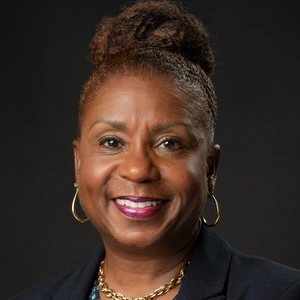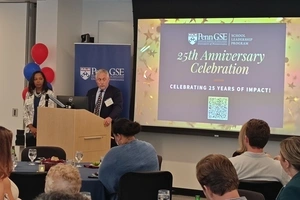Faculty Expert
-
Sigal Ben-Porath
MRMJJ Presidential Professor
Policy, Organizations, Leadership, and Systems Division -
Andrea M. Kane
Professor of Practice, Education Leadership
Policy, Organizations, Leadership, and Systems Division
The topic of free speech in education is broad, with opinions cutting across political affiliations and generations. It encompasses everything from what teachers can say in their classrooms, what books school boards allow, and even what opinions students will tolerate speakers to express. A recent conversation between professors Sigal Ben-Porath and Andrea M. Kane tackled this rich subject as part of “You Can’t Say That! Current Challenges to the Boundaries of Free Speech in K–12 and Higher Education.” Dean Pam Grossman moderated the panel during Penn’s annual Homecoming Weekend.
“Education is a crucible of democracy,” said the dean in her introduction, setting the stage for the wide-ranging conversation. “Public education is the thing that advances democracy, but it’s also where so many challenges are raised.”
Ben-Porath, author of the forthcoming book, “Cancel Wars: How Universities Can Foster Free Speech, Promote Inclusion, and Improve Democracy,” explained that while her current research focuses on higher ed, she believes the most important space for preparing future citizens to engage effectively is K–12 schools because they serve all students. (Only about a third of students attend colleges and universities.) She added that censorship issues are not new, but challenges to free speech feel particularly acute right now because the polarization in schools reflects a broader polarization in the country.
“This particular form of polarization isn’t related primarily to our policy perspectives, but a significant aspect is what scholars call ‘affective polarization,’ or in other words, ideological contempt. So, what we are seeing is that a lot of people have strong negative emotions about people on the other side of the aisle. And the strong negative emotions are playing out at all levels, right? . . . This isn’t just playing out in Congress, in the Senate. It's playing out in our schools, in our neighborhoods, our school boards, where we shop, who we talk to, and what media we watch.”
Kane -- whose 25-year career in public schools includes stretches as a para-professional, teacher, assistant principal, principal, and tenure as the superintendent of schools in Queen Anne’s County, Maryland -- brought the perspective of a practitioner to the discussion. She was troubled that, in states where the curriculum has been legislated, those rules have made teachers and administrators less sure of what they can and cannot say in their classrooms.
“You have this legislation created by people who aren’t educators and who are not positioned in classrooms to deal with what students’ questions are,” she said. “Everybody is really, really confused.”
Kane also noted that such oversight by politicians who may not have any experience in education also makes educators feel disrespected: “From my perspective, this is a reflection of the value that we, as Americans, place on education, and the respect that we have for the roles of the teacher, the principal, the leaders in the building. . . I think we haven’t respected the profession, and when you don’t respect the profession, you have people coming in as regulators, as if we can’t do it for ourselves."
Kane and Ben-Porath both agreed that classrooms are the places to have difficult conversations, confront tragic moments in American history and tell the truth about things. Such discussions require educators to have the authority to make decisions about their classrooms while still respecting the role of school boards and other community oversight. It’s a balancing act. "We want our communities engaged in schools. We want to hear from them. We want them to have an active role in decision-making and what curriculum we choose," said Kane.
Kane said school boards do a "disservice" to students, however, when they make curriculum decisions based on politics. Ben-Porath added an example, explaining that many school boards across the country have recently tried to prevent or suppress the teaching of slavery as a part of American history. Those moves aren’t the result of a sea change in public opinion about curriculum but are instead due to voter disengagement – or rather, participation by a very vocal minority. Involvement in school board elections is at about 15 percent, said Ben-Porath, creating "a very low bar for people who want to take them over and participate in them for reasons of political expediency or to promote a certain agenda that is narrow and extreme."
The solution? More participation and voter engagement, especially in local elections such as those for school boards. “Democracy doesn’t operate itself. Democracy isn’t a spectator sport,” said Ben-Porath. “We have to make sure the different voices in the community are reflected in our school boards, and we have to do it to the benefit of all children.”
The rest of the afternoon’s conversation focused on how educators can train and support students to have civil dialogue across differences. "We have to model for our children how to express themselves with respect—how to disagree with people and still have a relationship and be able to communicate—and that this is normal,” said Kane.
Part of the challenge, said Ben-Porath, is that the current polarized political moment has left people distrustful of those with whom they disagree—especially because there are extremist groups who benefit from the division. (Think of all the publicity such groups get when students protest a campus appearance by one of their members.) This environment is made trickier when people on different sides of an issue exist in separate media silos and may hear entirely different sets of "facts."
“We have to teach children evidentiary practices, media literacy, being able to recognize truth from falsity and prioritizing the truth when they do,” said Ben-Porath. “Because if we don’t have the same view about reality . . . we cannot make policies together because we are responding to and reflecting a different reality.”
The critical work of dialogue across differences is an endeavor that both professors understand intimately from their classrooms at GSE. In Kane's classroom, she creates “a safe space” for the educational leaders she is training to share the problems they are facing in their schools and to workshop them with the group.
“Equity is always at the forefront of what we do—not just from me, but from everyone in the classroom,” she said. “What can we do to support our LGBTQ students? What we can do to support our marginalized students—marginalized because of race, ethnicity, language, ability, all of those things? Those are real issues being dealt with in school districts today.”
Ben-Porath also believes in the principle of the classroom as a "safe space." She refutes the perception among some that such safe places don't allow for difficult conversations -- that they are safe from controversial topics. Instead, she believes that her students can have honest, open dialogues precisely because she has made them "safe." To her, a "safe space" is an environment where good faith is assumed, and people are trusted to be respectful.
“We have to give each other grace in our own classrooms, and model that, and offer people opportunities to grow and learn,” she said. She offered an example of what she would do if someone shared a biased opinion in class. Would she shame them and reject them from the classroom community? No. She would "embrace the person while rejecting their words" and try to teach them why they were wrong.
“My job is not to get you canceled. It's not to shame you because you’re holding misinformed views. My job is to help you grow. As educators, we have to believe that everyone is redeemable.”
As the conversation wound down, Dean Grossman suggested that maybe “safe spaces” should be renamed “educative spaces.”
“We are a school of education,” she said before opening the floor to questions. “We are all here to grow and to learn. That is our mission.”
Media Inquiries
Penn GSE Communications is here to help reporters connect with the education experts they need.











